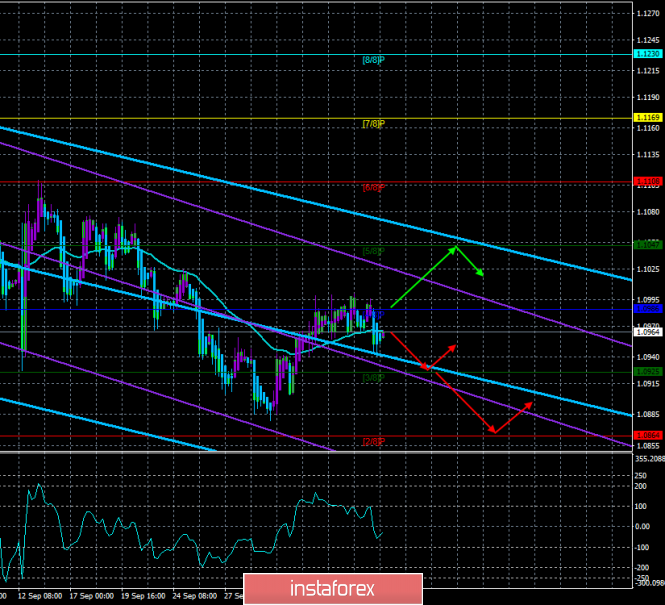4-hour timeframe

Technical data:
The upper channel linear regression: direction – down.
The lower channel linear regression: direction – down.
The moving average (20; smoothed) – sideways.
CCI: -24.9824
Yesterday, we talked several times about the fact that the speeches of the head of the Fed Jerome Powell do not cause any reaction among traders, as they do not contain anything new and interesting. And that evening, Powell shocked the markets by announcing that the Fed was starting to buy up American securities from the open market again. At a meeting of the National Association for Business Economics in Denver, Powell said that recent problems of a "technical nature" had led the regulator to consider buying short-term treasury bills. Powell also said that back in March, the Fed reported that the time will come when the portfolio of securities will begin to expand again. However, Powell said that this is not a new phase of the quantitative easing (QE) program, which was conducted three times between 2008 and 2014. The Fed does not plan to conduct large-scale asset purchases, and purchases of securities will not lead to a significant change in US monetary policy.
At the same time, Jerome Powell said that the US economy does not need to be stimulated, and the labor market and inflation are in a favorable state. Where did the phrase "insufficient inflation" go if the consumer price index itself has not changed for the better in recent months? We believe that Powell has recently begun to openly dissemble. First, he claims that the Fed is independent of political influence, but the organization follows the requests/orders/appeals of Donald Trump. Now Powell says that it's not about the launch of full-scale QE4, but at the same time, assets will be bought from the market. Many traders and analysts have dubbed the Fed's move as a "mini-QE." If long-term government bonds were bought up in the framework of previous QEs, now short-term bills are planned for redemption to "restore the level of reserves in the financial system", but the essence remains the same. Saturation of the open market with the money supply.
The most surprising thing is that traders did not react to this speech of Powell. Either they were reassured by the wording "this is not QE," or they have not yet fully realized that the Fed is starting to re-buy assets on its balance sheet, but the US dollar, paired with the euro, did not budge one iota last night.
Today, again, there will be no macroeconomic publications either in the States or in the European Union. Only in the evening, there will be another speech by Jerome Powell, which will be monitored with increased attention by participants of the Forex market. We are still waiting for at least a small decline in the US currency, but to be able to trade it off, we also recommend waiting for the pair to consolidate above the moving average line.
Nearest support levels:
S1 – 1.0925
S2 – 1.0864
S3 – 1.0803
Nearest resistance levels:
R1 – 1.0986
R2 – 1.1047
R3 – 1.1108
Trading recommendations:
The euro/dollar pair has fixed back below the moving average line, so the trend for the pair has again changed to a downward trend. Thus, the bears are recommended to resume selling the euro currency with the aim of Murray's level of "3/8" – 1.0925. Purchases of the pair can be considered with a target of 1.1047 if the bulls manage to overcome the level of 1.0986.
In addition to the technical picture, fundamental data and the time of their release should also be taken into account.
Explanation of the illustrations:
The upper channel of linear regression – the blue lines of the unidirectional motion.
The lower channel of linear regression – the purple lines of the unidirectional motion.
CCI – the blue line in the indicator window.
The moving average (20; smoothed) – blue line on the price chart.
Murray levels – multi-colored horizontal stripes.
Heiken Ashi – an indicator that colors bars in blue or purple.
The material has been provided by InstaForex Company - www.instaforex.com